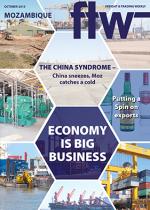Drop in Zambian copper exports shrinks volumes through Beira
Although Maputo and
Beijing are more than
11 000 kilometres or
6 000 nautical miles
apart, the Chinese slowdown
is sending ripples through the
Mozambican economy.
This is despite the fact that
the country is not itself a major
producer of commodities.
In August this year UK-based
company Fathom Consulting
released the results of an
analysis it carried out of the
links between 19 African
countries and China.
Mozambique is ranked as the
eighth most vulnerable country.
To put Chinese demand in
context, annually the country
consumes 54% of aluminium,
48% of copper, 50% of nickel,
45% of all steel, and 60% of
concrete.
Some 9% of Mozambican
gross domestic product (GDP) is
exposed to China, according to
Fathom Consulting.
Two of Mozambique’s
neighbours – Zambia and South
Africa – are listed among the
top three most vulnerable, the
other being Liberia.
A drop in Zambian exports
of copper has a direct impact
on volumes through the port of
Beira, which handles both the
importation of chemicals and
the export of copper ingots and
cathodes.
Similarly, a reduction in
steel output
by Chinese
factories
impacts directly
on the demand
for coking coal.
Zambia,
according
to Fathom, could also face a
reduction in Chinese direct
foreign investment – which
would impact further on the
country’s economic growth.
With Zambia being landlocked,
any changes in its
economy are felt immediately by
the Mozambican logistics sector
– particularly in Beira.
Lower volumes mean stronger
competition from other ports
such as Dar es Salaam, Walvis
Bay and Durban.
The impact is felt throughout
the economy.
In Beira in particular hotels
– which in previous years have
been full – were half empty.
This in a country where,
according to The World Travel
& Tourism Council, business
travel spending
accounts for
46.8% of the
total tourism
spend in the
country.
Earnings
from business
travel were expected to reach
over R4 billion in 2015.
But, what has most affected
Mozambican prospects and
business sentiment in the short
term is the fall in gas and coal
prices.
Huge deposits of coal and
gas found in the north were
expected as little as two years
ago to provide the fuel for an
unprecedented boom.
Now mines are being run
on short time, the last of the
exploration rigs has left, and the
industry is nursing huge debts.
According to the Ministry of
Economy and Finance, revenue
from mining decreased by 2.6%
between 2013 and 2014 due to
the drop in coal prices.
Earlier this year the
International Monetary Fund
(IMF) predicted that coal
production would remain flat in
2015 due to the low prices.
Over the medium to long
term the outlook is much rosier.
A September 2014 Business
Monitor International report
predicts that Mozambique will
become one of the 10 largest coal
exporters in the world by 2018.
Demand for natural gas is
also expected to grow as world
demand increases.
The drop in Chinese demand
gives Mozambique and
the traders and businesses
operating in the country an
opportunity to diversify.
INSERT
9% The percentage of Mozambique’s GDP
exposed to China.
CAPTION
A coal vessel at the Port of Beira.

